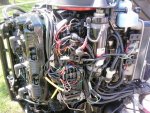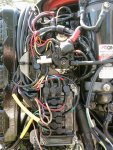Re: 1988 Merc Black Max 135hp Charging problems
Fire your tech. She don't even know what to test. She was on one of the switchbox charge coil sets.
The device on the switchbox mounting plate is a bridge rectifier. One terminal is labeled +. The other two are stator connections. Make sure it's hooked up right. There's a FAQ on this site that has testing procedure for it.
The device on the top is a stator saturation regulator. It is NLA, probably because it's value is somewhere between useless and hazardous. (as in fire starting) If it's shorted it would take out a mercury rectifier in a heartbeat. If you put in one with decent parameters (ie radio shack 20 amp bridge rectifier) it wouldn't blow, but would probably ignite the regulator.
1. disconnect and test the rectifier with an ohmmeter and the FAQ I referred to. Replace if bad.
2. Measure the resistance between the yellow wires. It should be less than 1 ohm, but not 0. There should be no continuity (infinite resistance) between either yellow and ground.
3. When you re connect the rectifier, make sure the wires are on the right terminals.
4. Disconnect the regulator, at least for now, probably permanently.
If the stator is bad, it needs to be replaced.
Options from there
1. Install a fresh murkery rectifier, might as well stock spares.
2. Fit a better bridge rectifier.
3. Install a 16-20 amp regulator, commonly used on later engines in pairs. You only need one.
If you don't install a regulator, the battery will do the job. It will use some water doing it. If it is regularly maintained, it's life will not be shortened.
hope it helps
john


 Greets to all since this is my first posting here. First a short run up. As I stated in the thread description, I have a 1988 Merc Black Max 135hp Oil Inject motor SN-0B304160. I've been experiencing charging problems in that I'm only getting about 12.4 - 12.7v output with about 1.8 -2.1amps output as well. This is at low speed and medium speed (about 20-25mph). I brought the boat in to get checked and was told my rectifier was shot. I had it replaced. The tech said that there was a hole burnt through it. I got the boat back and tested it on the water. The highest voltage output I measured was about 12.6vdc and the amps were about 2.7. I brought it back to the same shop and told the tech what I found out. She checked the stator for me and said that the high side was at about 130 and that it was a bit low but was still in working order. The low side was at 35 I believe. Apparently the stator had checked out OK. As I asked questions about the charging path, she deduced that there was a secondary rectifier on the top of my engine at the back. She didn't know for sure since she didn't know what this part was exactly. I asked if the part was a voltage regulator but she didn't think so. Can anyone tell me their opinion on the charging problem or this secondary rectifier/regulator? I've attached three pics. The one of the right side view shows the old rectifier assembly obscured before replacement. It's to the left of the solenoid. The top of the engine shows the suspected secondary rectifier or regulator I was talking about. It's to the right of the black box and is the one with the yellow and red wires coming out of the top.
Greets to all since this is my first posting here. First a short run up. As I stated in the thread description, I have a 1988 Merc Black Max 135hp Oil Inject motor SN-0B304160. I've been experiencing charging problems in that I'm only getting about 12.4 - 12.7v output with about 1.8 -2.1amps output as well. This is at low speed and medium speed (about 20-25mph). I brought the boat in to get checked and was told my rectifier was shot. I had it replaced. The tech said that there was a hole burnt through it. I got the boat back and tested it on the water. The highest voltage output I measured was about 12.6vdc and the amps were about 2.7. I brought it back to the same shop and told the tech what I found out. She checked the stator for me and said that the high side was at about 130 and that it was a bit low but was still in working order. The low side was at 35 I believe. Apparently the stator had checked out OK. As I asked questions about the charging path, she deduced that there was a secondary rectifier on the top of my engine at the back. She didn't know for sure since she didn't know what this part was exactly. I asked if the part was a voltage regulator but she didn't think so. Can anyone tell me their opinion on the charging problem or this secondary rectifier/regulator? I've attached three pics. The one of the right side view shows the old rectifier assembly obscured before replacement. It's to the left of the solenoid. The top of the engine shows the suspected secondary rectifier or regulator I was talking about. It's to the right of the black box and is the one with the yellow and red wires coming out of the top.


















